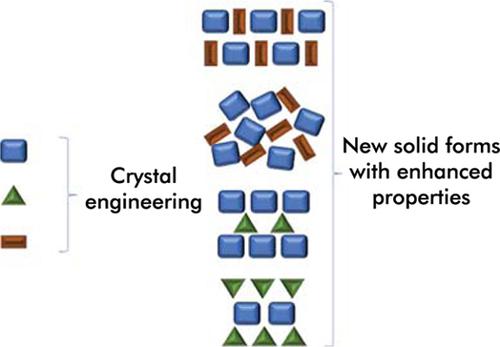Mini-Reviews in Organic Chemistry ( IF 1.9 ) Pub Date : 2020-07-31 , DOI: 10.2174/1570193x16666190430153231 Andrea Mariela Araya-Sibaja 1 , Cinira Fandaruff 2 , Krissia Wilhelm 3 , José Roberto Vega-Baudrit 1 , Teodolito Guillén-Girón 4 , Mirtha Navarro-Hoyos 3

|
Primarily composed of organic molecules, pharmaceutical materials, including drugs and excipients, frequently exhibit physicochemical properties that can affect the formulation, manufacturing and packing processes as well as product performance and safety. In recent years, researchers have intensively developed Crystal Engineering (CE) in an effort to reinvent bioactive molecules with well-known, approved pharmacological effects. In general, CE aims to improve the physicochemical properties without affecting their intrinsic characteristics or compromising their stability. CE involves the molecular recognition of non-covalent interactions, in which organic materials are responsible for the regular arrangement of molecules into crystal lattices. Modern CE, encompasses all manipulations that result in the alteration of crystal packing as well as methods that disrupt crystal lattices or reduce the size of crystals, or a combination of them. Nowadays, cocrystallisation has been the most explored strategy to improve solubility, dissolution rate and bioavailability of Active Pharmaceutical Ingredients (API). However, its combinatorial nature involving two or more small organic molecules, and the use of diverse crystallisation processes increase the possible outcomes. As a result, numerous organic materials can be obtained as well as several physicochemical and mechanical properties can be improved. Therefore, this review will focus on novel organic solids obtained when CE is applied including crystalline and amorphous, single and multicomponent as well as nanosized ones, that have contributed to improving not only solubility, dissolution rate, bioavailability permeability but also, chemical and physical stability and mechanical properties.
中文翻译:

晶体工程到固体设计:从单组分到多组分有机材料
药物材料主要由有机分子组成,包括药物和赋形剂在内,其理化性质经常会影响制剂,制造和包装过程以及产品性能和安全性。近年来,研究人员大力开发了晶体工程(CE),以重塑具有公认的药理作用的生物活性分子。通常,CE旨在改善其理化性质而不影响其内在特征或损害其稳定性。CE涉及非共价相互作用的分子识别,其中有机材料负责将分子规则排列成晶格。现代CE 涵盖了所有导致晶体堆积改变的操作,以及破坏晶格或减小晶体尺寸的方法,或它们的组合。如今,共结晶是提高活性药物成分(API)的溶解度,溶出度和生物利用度的最探索的策略。但是,其组合性质涉及两个或多个有机小分子,并且使用各种结晶过程会增加可能的结果。结果,可以获得多种有机材料,并且可以改善几种物理化学和机械性能。因此,本文将重点介绍应用CE时获得的新型有机固体,包括晶体和无定形,单组分和多组分以及纳米级,











































 京公网安备 11010802027423号
京公网安备 11010802027423号